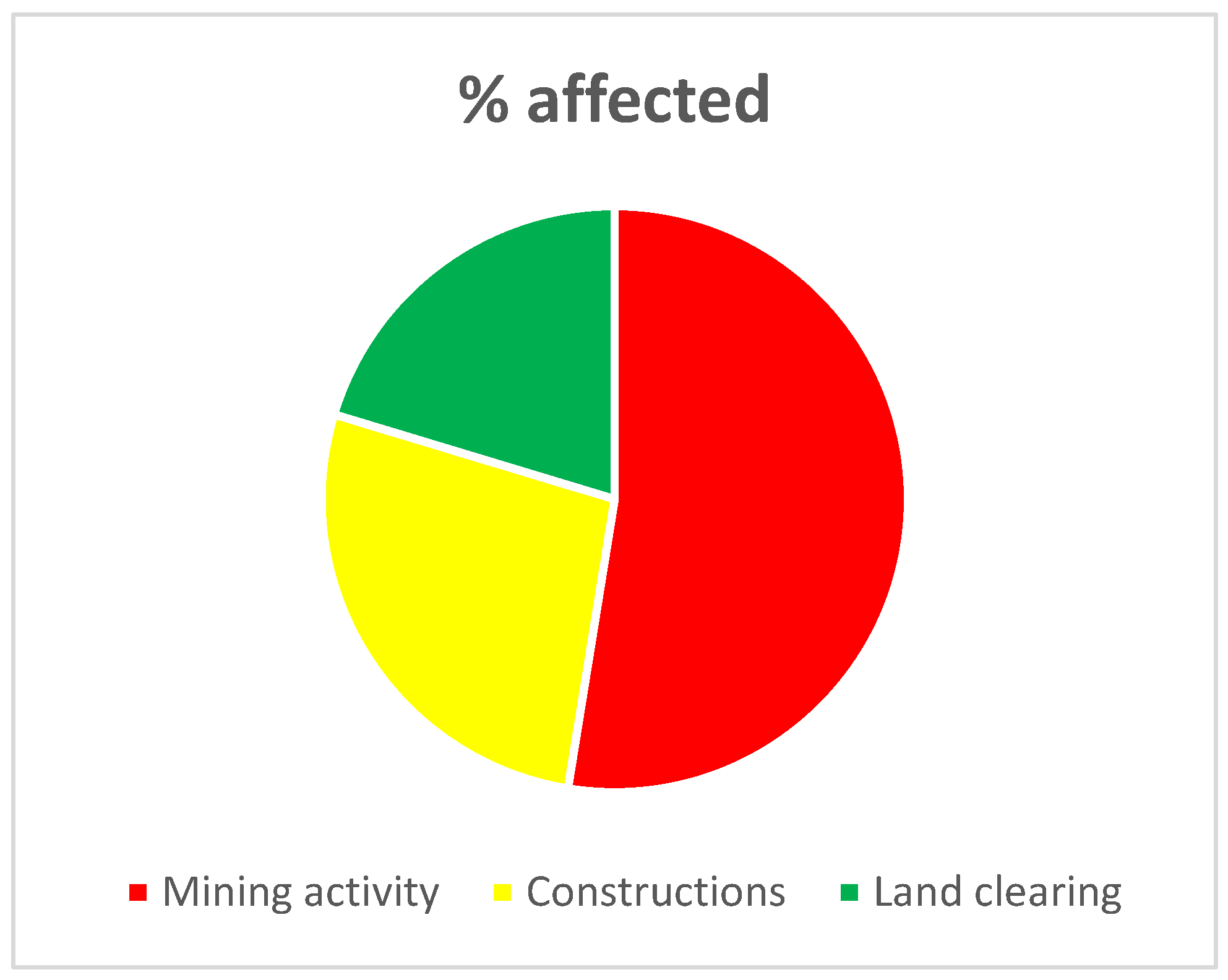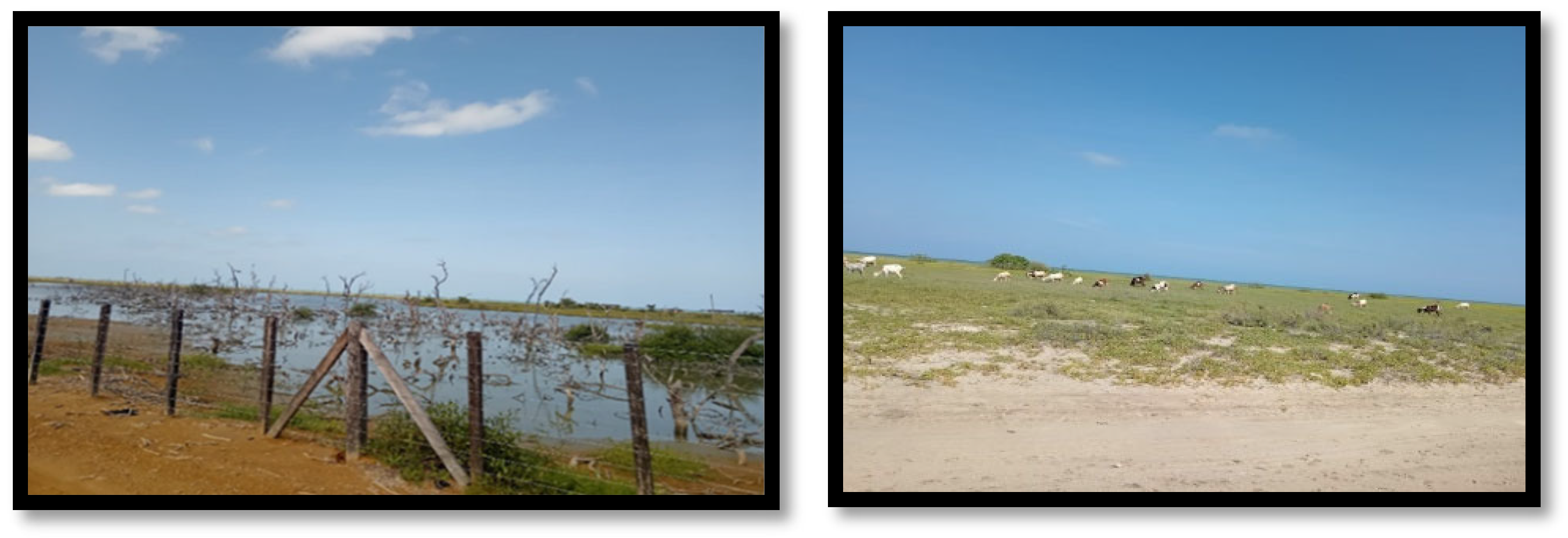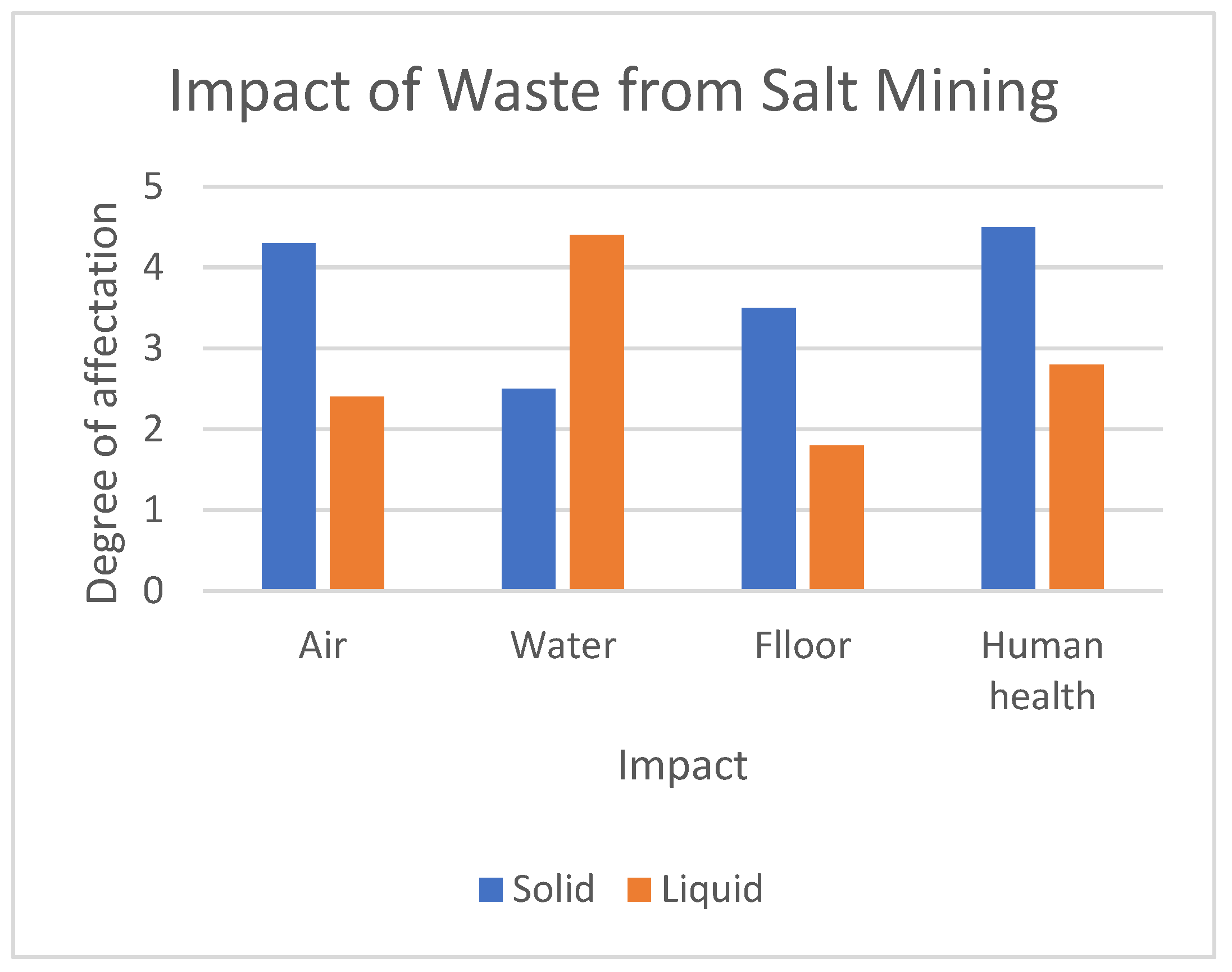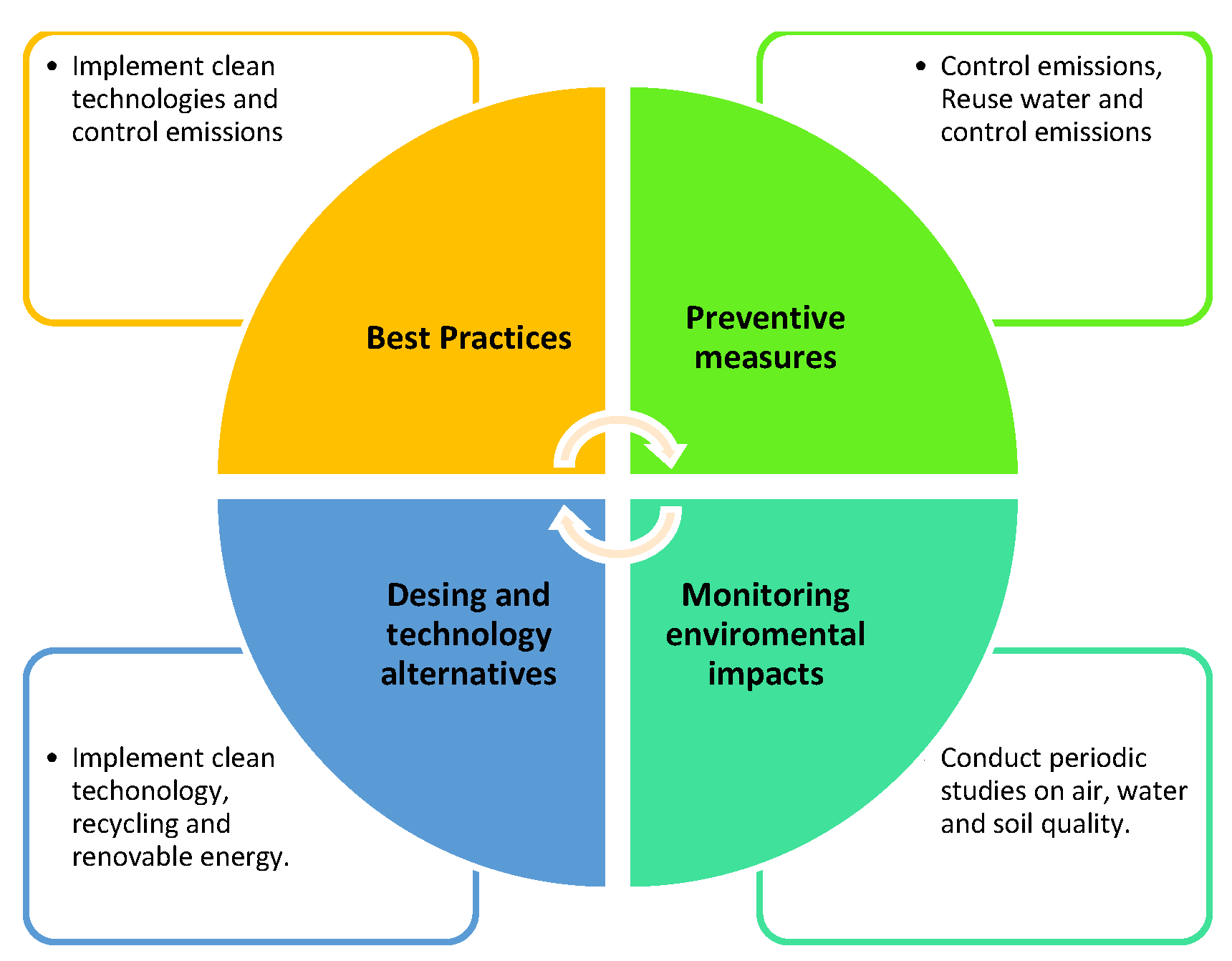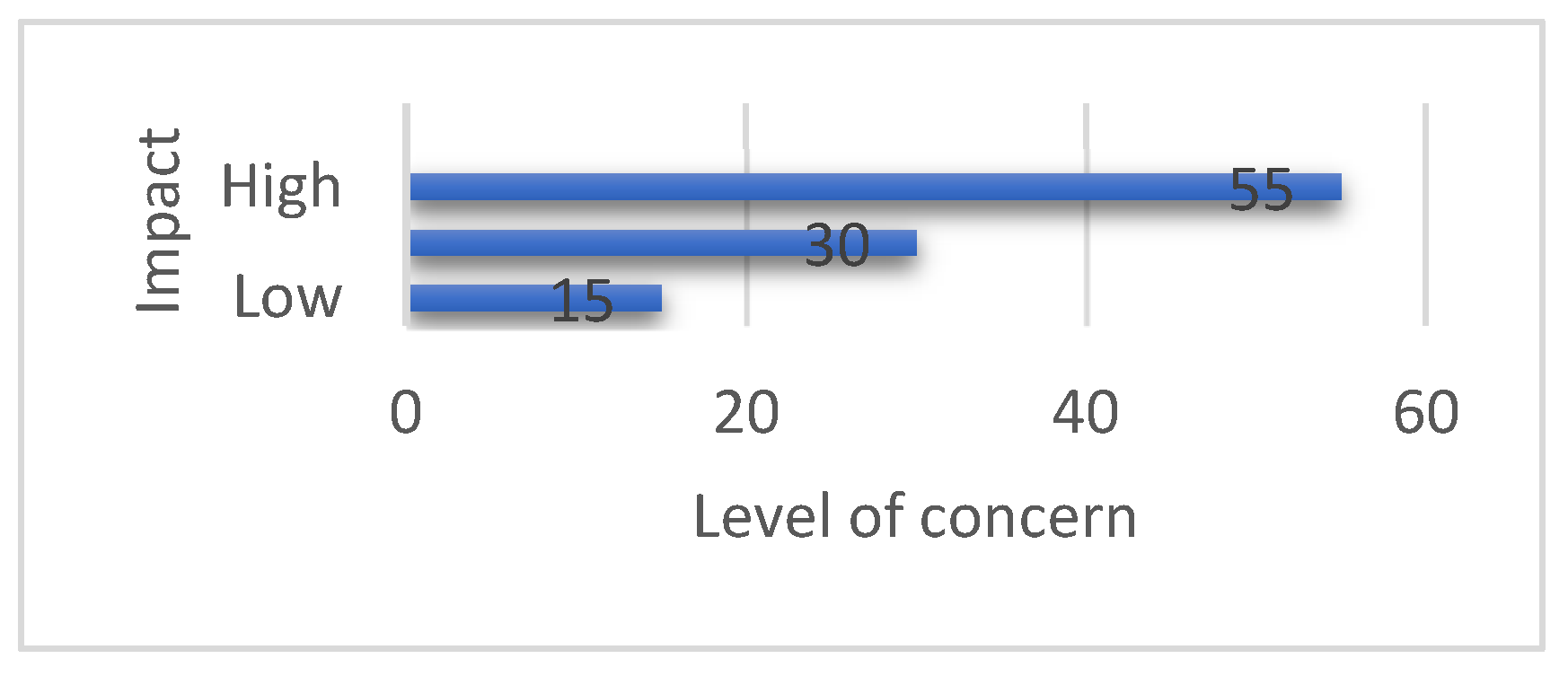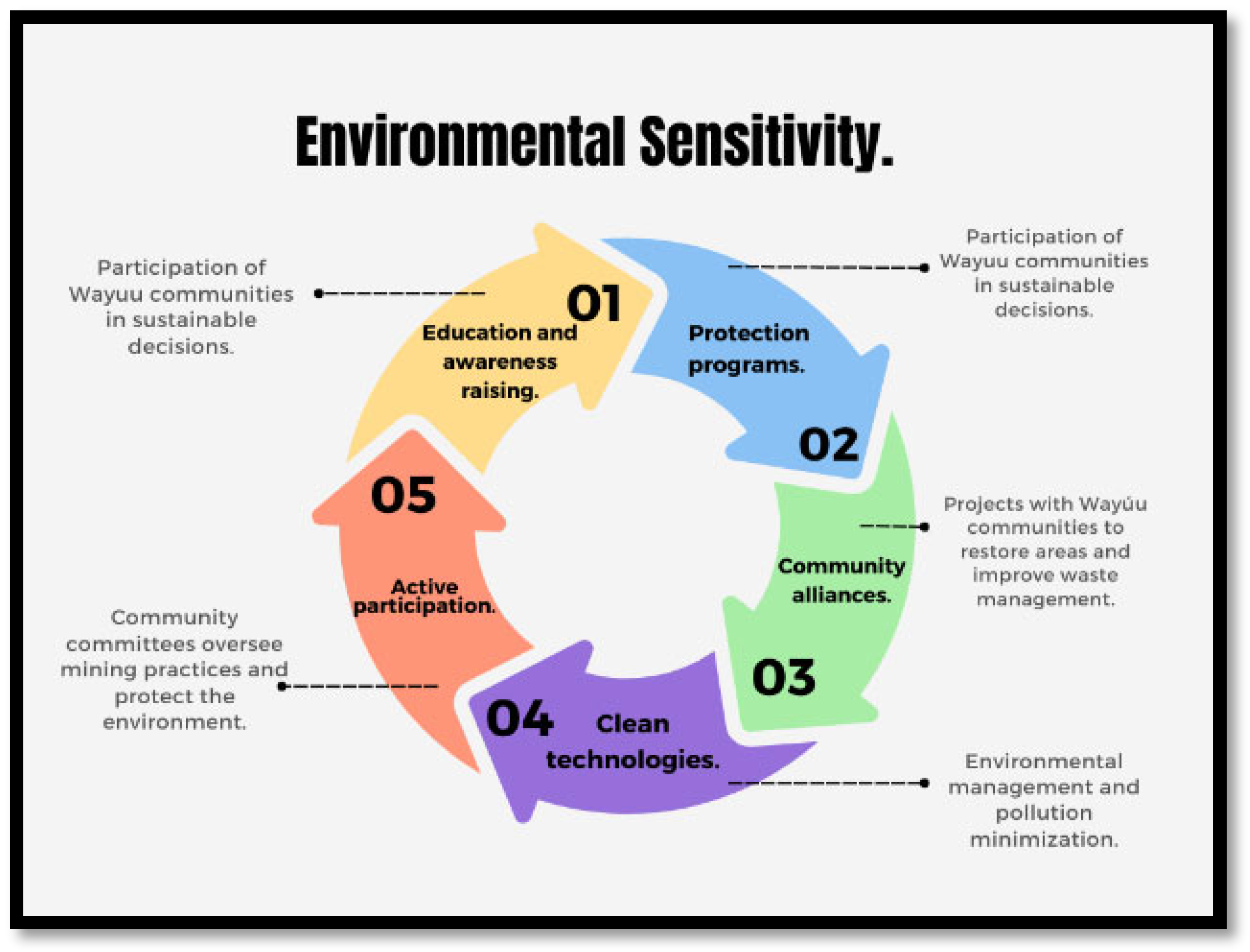1. Introduction
Globalization has been pursuing economic conquest without considering its costs. In this process, various elements converge on an international level, promoting excessive supply and demand without limits or borders, which impacts consumption patterns, the Earth’s capacity, and the ecological footprint by generating surplus products in both advanced and emerging economies [
1]. For this reason, the repercussions of excessive consumption on secondary consequences, such as climate change, are evident [
2].
In [
3], UNESCO Director Koichiro Matsuura emphasized in Paris that sustainable development is both a moral principle and a scientific concept, linked to peace, human rights, equity, ecological theories, and global warming.
Therefore, environmental sustainability involves interacting responsibly with the environment, aiming to prevent the depletion or deterioration of natural resources and to ensure long-term environmental quality [
4].
In its early stages, this was perceived as a costly process and considered an obstacle to economic progress. However, the environmental issues resulting from the lack of sustainability integration into economic, social, and cultural aspects became evident [
5].
Environmental sustainability is also presented as an alternative to the questionable concept of sustainable development, adopting a biocentric and deeply humanistic perspective while avoiding an anthropocentric approach [
6].
Additionally, through sustainability, strategies have been implemented within salt mining companies in such a way that they help them establish a culture that cuts across different sectors, seeking to promote environmental sustainability in the territory [
7].
In Colombia, mining activity has played a fundamental role in the national economy, serving as a significant generator of wealth for the government, companies, and territorial entities. However, its exploitation has caused various environmental impacts, including water contamination, damage to ecosystems, and pollution that affects human health [
8].
Therefore, it is essential to adopt a responsible approach to the use of mineral resources, promoting their renewal, the recycling of industrial waste, and the reuse of products. The circular economy represents an innovative growth model, especially considering that mining companies face significant challenges in fully eliminating the social and environmental impacts of their activities [
9].
It is important to highlight that salt mining is a productive sector with a high potential to boost the economy of the department of La Guajira. It is reported that several companies dedicated to the extraction and production of salt operate in this region, with a capacity of one million tons per year, which represents 70% of the country’s total capacity in this area [
10].
This is how the municipality of Manaure, La Guajira, holds significant importance in terms of marine–terrestrial ecosystems in the country and is home to substantial salt flats. Salt extraction is traditionally carried out by the indigenous Wayuu families. These families, relying on their ancestral knowledge, take advantage of the flat terrain near sea level and favorable climatic conditions, such as constant sun exposure, strong winds, and low precipitation. Thanks to these factors, they have established themselves in the local market as producers of 70% of the country’s salt [
11].
Additionally, the climatic conditions during working hours are extreme, with temperatures ranging between 35 and 40 degrees Celsius. Prolonged exposure to the sun and contact with saltwater or brine at high temperatures can cause numerous skin diseases [
12]. This situation results in devastating climatic effects, underscoring the reality that the planet has a finite carrying capacity and that we are rapidly approaching ecosystem collapse [
13]. Legal and illegal mining activities exacerbate environmental degradation, causing water pollution, desertification, and species displacement due to a lack of proper care during exploitation [
14].
As previously described, environmental sustainability involves adjusting communities and their activities to the Earth’s capacity to supply resources and withstand pollutant emissions over time [
15].
In Colombia, despite some advancements, there remains a need to fully strengthen and assimilate the concept of environmental sustainability in all its dimensions. This would allow progress toward education focused on sustainable development [
16]. Achieving this requires collaboration between the public and private sectors, as well as international cooperation, to guarantee environmental sustainability in the industry [
17].
Recently, there has been a noticeable increase in public awareness regarding environmental issues, and nations have acknowledged the urgent need to improve their environmental performance [
18].
Today, mining remains an essential economic activity for human life and development. However, given its substantial environmental impact, addressing these issues is imperative [
19]. Environmental concerns include soil modification, alteration of vegetation and local rivers during site preparation; air pollution from separation, concentration, and processing activities (through fugitive dust and chimney emissions); noise associated with transportation, transfer, crushing, and grinding of minerals; surface water contamination caused by waste from mills and washing plants; visual impacts; waste disposal challenges; and conflicts over land use [
20].
The use of sustainability assessments emerges as a valuable approach to address global challenges related to the environment and ecology, such as preserving forest vegetation, reducing greenhouse gas emissions, and promoting sustainable development [
21].
Moreover, under the new international framework for extractive industries, mining companies are increasingly inclined to collaborate with governments, communities, and other stakeholders to develop policies aimed at generating spillovers of knowledge and innovations in the mining value chain and other industries [
22].
To address these challenges, it is crucial to implement environmental management policies and practices that prioritize the conservation of natural resources and the well-being of local communities. This involves setting clear limits on water extraction, promoting more sustainable exploitation techniques, improving waste management, and ensuring meaningful community participation in decision-making processes.
Therefore, the following research aims to analyze environmental sustainability as a key practice adopted by salt mining companies to minimize environmental impacts.
3. Results
3.1. Environmental Impact
In Manaure, La Guajira, salt mining has been a predominant activity with significant impacts on the structure and composition of the soil. The high salinity resulting from salt extraction can limit the variety of plant species that survive in the area, as shown in
Table 3, thereby reducing biodiversity and affecting ecological recovery. The biophysical capacity of the soil in this region is affected by high concentrations of salts, which contribute to limiting the diversity and density of vegetation.
As shown in
Table 3, the presence of native plant species in the mining area is significantly low in relation to the extension of the territory, as occurs in the municipality of Manaure, La Guajira. This is mainly due to the exploitation of salt in the region, as indicated by the affected community.
Now, the soil capacity in the mine area is often significantly altered to adapt to the needs of mining activity. As shown in
Figure 1, the percentage of impact caused by the construction of facilities, land clearing, and salt mining itself, implies a considerable modification of the soil, affecting its natural composition and its capacity to support the original vegetation.
Mining activity has a significant impact on the environment, not only due to the extraction of natural resources, but also due to the construction and infrastructure required for its development. These activities can alter the ecosystem, affect soil and water quality, and contribute to deforestation and loss of biodiversity.
The deterioration of vegetation in the Salt Mine occurs mainly due to the intervention in the area required for the construction of the mine. The elimination of native vegetation and soil compaction can lead to a decrease in its fertility and a greater susceptibility to erosion, as can be seen in
Figure 2. In addition, the construction of infrastructure on these soils can hinder the recovery of the ecosystem once mining activities cease, unless appropriate environmental restoration plans are implemented.
On the other hand, regarding water resource contamination, the mine has taken significant measures to mitigate its impact. Water is a vital resource for the operations of the salt mine in Manaure, La Guajira, as it is essential for both the extraction process and waste management. Proper water management is crucial to minimizing environmental impact and ensuring the sustainability of mining activities.
Additionally, during a visit to the salt mine in Manaure, La Guajira, the issue of noise emissions was addressed. However, it was noted that the predominant noise comes from the vehicles entering the mine. This type of noise is considered non-detrimental to the environment. Furthermore, the industrial plants within the mine also generate some level of noise; however, it is not deemed significant, as explained in
Figure 3.
3.2. Environmental Processes
During the conducted interview, no specific information was provided regarding circular economy practices, as shown in
Figure 4, or the management of natural resources in the salt mining operations in Manaure, La Guajira. However, it is essential to address these topics due to their relevance to the sustainable management of mining activities and their environmental impact.
The consumption of natural resources in salt mining involves the continuous extraction of salt from the environment, which can lead to the depletion of these resources if not managed properly. In this context, the circular economy emerges as a crucial approach to sustainability. Such an approach can be fundamental for salt mining, as it promotes the reuse and recycling of materials, the reduction of waste, and the adoption of more responsible production practices.
Regarding the waste generated during salt extraction, it is evident that these operations can produce various types of waste, such as solid and liquid waste. Improper management of this waste can lead to air, water, and soil pollution, negatively affecting the natural environment and the health of nearby communities, as shown in
Figure 5, in which respondents selected the areas where they consider that inadequate salt extraction has a significantly negative impact. Therefore, it is vital to implement appropriate waste management and disposal measures to mitigate these impacts.
Regarding waste reduction measures, no detailed information on specific practices implemented at the mine was provided during the interview. Nevertheless, it is crucial to implement effective strategies to minimize resource waste in mining operations.
All of this is intended to encourage companies to take advantage of implementing a circular economy in mining areas, for example, by implementing recycling, reusing water resources wasted during salt washing, and restoring areas that have been negatively impacted by changes in the environment, such as the decline of the region’s native flora due to mining practices.
During the outreach, it was revealed that most airborne particulate matter originates from sources such as wind and vehicles rather than direct mining operations. However, it is evident that the mine should adopt robust practices to manage these environmental risks. Recommended measures include installing filtration systems to control dust emissions and other airborne contaminants. Additionally, effective methods should be implemented for treating wastewater generated during the extraction process, as well as techniques to control soil erosion and prevent sedimentation in nearby water bodies.
Regarding the preservation and protection of local biodiversity affected by mining activities, no specific details were provided. It is essential to implement conservation strategies that protect critical habitats and ensure the survival of local species, as shown in
Figure 6, to achieve a circular economy.
Monitoring the negative environmental impacts is essential; however, the exact methods were not specified during the discussion. Generally, monitoring is carried out through periodic studies and the collection of data on air, water, and soil quality. Noise and air pollution studies are important to identify sources of contamination and assess their impact.
3.3. Strategic Lines
In salt mining in Manaure, La Guajira, mechanisms for environmental citizen participation have been implemented to ensure that the local community, primarily the Wayuu, is involved in decisions and actions related to the environment. The mine conducts regular meetings and consultations with the community to identify and address specific environmental issues.
These mechanisms allow residents to voice their concerns and actively participate in the environmental management process. During visits, the level of concern within the communities was assessed, promoting constructive dialogue between the involved parties. The results are presented in
Figure 7.
Based on these results, the mine conducts continuous studies and monitoring of the environment, focusing on areas affected by salt extraction and processing. These studies help detect contamination levels and assess impacts on air, water, and soil. The information gathered from these studies is used to develop effective mitigation strategies and measures.
Specific actions implemented to mitigate environmental problems include a number of practical measures. Advanced filtration systems have been installed to control dust emissions and other air pollutants, helping to maintain air quality at acceptable levels. Humidification methods have also been adopted in extraction areas to reduce dust generation. In terms of wastewater management, systems have been established for its treatment and recycling, ensuring that no pollutants are discharged into nearby water bodies. Since during the intervention, respondents emphasized those areas where salt extraction has a significant negative impact,
Figure 8 shows the effectiveness of these strategies.
To monitor the effectiveness of the adopted environmental measures, periodic evaluations are conducted, including the analysis of air, water, and soil samples. These evaluations allow for the measurement of pollutant levels and verification of whether the mitigation practices are performing as expected. The results of these evaluations are used to adjust strategies and continuously improve environmental practices, ensuring compliance with sustainability standards and minimizing negative impacts.
Additionally, various strategies have been implemented to promote environmental awareness and ensure the protection of natural resources, as shown in
Figure 9. Among the main strategies are initiatives focused on environmental awareness and education, targeting the Wayuu communities and the general population. These strategies include workshops and training sessions addressing topics such as the environmental impact of mining, the importance of recycling, and proper waste management.
Environmental awareness programs in salt mining in Manaure focus on protecting natural resources through educational campaigns and community activities. These programs include cleaning days for affected areas, promoting recycling practices and waste reduction, and distributing informational materials on water and soil conservation. Additionally, events are organized to facilitate knowledge exchange between mine workers and local residents, thereby strengthening mutual understanding of the importance of environmental stewardship.
4. Discussion
Salt mining highlights the complexity of interactions between the activity and the natural environment. Through research and monitoring, both progress achieved and areas needing greater attention have been identified [
24]. One notable aspect is the improvement in air and water quality in some areas, attributed to the use of advanced technologies and better environmental management practices. However, significant challenges remain that must be addressed to ensure the long-term sustainability of operations. As noted by Barros, Chamorro, Molina, and López [
25], the importance of providing a valuable methodology to evaluate environmental sustainability in the mining industry is emphasized, introducing the application of water and ecological footprint indicators in the specific context of a mining company.
Mining companies have invested significant efforts in identifying and mitigating pollution by conducting constant studies on air, water, and soil quality. Similarly, Caviedes and Olaya [
26] highlighted the importance of implementing measures that contribute to environmental conservation and the sustainable development of protected areas. Despite these efforts, water pollutants have been detected, which can affect the health of local communities and biodiversity. This underscores the need to implement an environmental management plan, as companies currently lack such an essential document, which should include the existing regulations and detailed actions to address environmental risks.
These measures could include the creation of protected areas and the promotion of sustainable mining practices that minimize the disturbance of natural habitats. Without such measures, local biodiversity could be seriously compromised, with negative consequences for the stability of ecosystems and the health of dependent species.
A key issue is waste management, as presented by Zapata [
27] in his research, which supports efficient and responsible management of mining activities. As part of the study, systems for waste collection and treatment have been established, but their effectiveness must be evaluated continuously. Moreover, collaboration with the community in waste management programs has been positive, yet more effective strategies are needed to reduce waste generation and increase recycling efforts.
It is also stressed that, should significant noise levels be recorded in the future, several measures could be implemented to mitigate their impact. First, a comprehensive noise assessment could be carried out through continuous monitoring to identify the most problematic sources and assess their real impact on the environment and human health. Based on these results, stricter noise limits could be set, and more advanced technologies could be adopted to control and reduce noise emissions.
5. Conclusions
Salt mining in Manaure has been an economically significant activity for the region, providing employment and essential resources for local communities, including the Wayuu population. However, its development has caused a series of adverse environmental impacts that compromise the health of the ecosystem and the quality of life of its inhabitants. Among the primary impacts are soil degradation, water pollution, habitat alteration, and the emission of pollutants.
Furthermore, salt mining has generated significant environmental impacts, primarily on soil structure and composition. The high salinity resulting from extraction limits plant diversity and affects the ecological recovery of the area. Furthermore, the elimination of native vegetation and soil compaction have reduced fertility and increased susceptibility to erosion, making ecosystem restoration difficult without appropriate interventions.
Mining activities involve the removal of large amounts of land, leading to the loss of topsoil and erosion. This negatively affects both biodiversity and the soil’s ability to support agricultural activities. Additionally, chemical leaks during the extraction process may worsen access to potable water in a vulnerable region like La Guajira. Other significant impacts include noise emissions, which not only affect mine workers but also disturb nearby communities, altering local fauna and their behavioral patterns.
In terms of water resources, the mine has implemented mitigation measures to reduce its impact, highlighting the importance of efficient water management to ensure the sustainability of the activity. Regarding noise emissions, it was determined that the predominant noise comes from vehicular traffic and industrial plants; however, their environmental impact is minimal.
Given this, it is essential to implement ecological restoration strategies that allow for the recovery of biodiversity and soil stability. Furthermore, continuous monitoring of water resources and environmental noise will help minimize the negative effects of mining activities, promoting more sustainable development in the region.
Salt mining companies must establish clear waste management procedures and conduct constant environmental monitoring. This includes water quality and biodiversity monitoring to enable early detection of problems. Furthermore, rehabilitating areas affected by mining through vegetation restoration is necessary, as it can generate long-term economic benefits for the communities.
It is also important to highlight that the lack of specific information on circular economy practices and resource management in salt extraction in Manaure, La Guajira, highlights the need to adopt sustainable strategies. Implementing a circular economy approach could optimize resource use, reduce waste, and mitigate environmental impacts. It is essential to establish measures for proper waste management, wastewater treatment, and the conservation of local biodiversity. Furthermore, continuous monitoring of air, water, and soil quality will ensure more responsible and sustainable mining in the region.
Finally, it is crucial to establish strategic guidelines that promote a sustainable model of salt mining. This includes adopting cleaner technologies, promoting environmental education programs, and creating partnerships between the company and local communities. The active inclusion of the Wayuu people in decision-making processes ensures that their concerns are addressed. Implementing corporate social responsibility policies that benefit local communities is key to ensuring that mining contributes to the social and economic well-being of the region.
Thus, salt mining in Manaure, La Guajira, has incorporated citizen participation mechanisms to involve the Wayuu community in environmental management, promoting constructive dialogue and informed decision-making. The implementation of ongoing environmental studies and monitoring has allowed for the assessment and mitigation of impacts on air, water, and soil through strategies such as filtration systems, wastewater treatment, and dust emission reduction techniques.
Furthermore, environmental awareness and education initiatives have strengthened the protection of natural resources and the sustainable management of mining activities. Periodic evaluation of the measures adopted guarantees their effectiveness and allows for continuous improvements, ensuring that mining operations align with sustainability standards and minimize their impact on the ecosystem and local communities.
